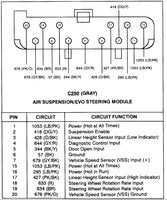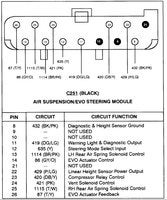DESCRIPTION
The rear air suspension/EVO control module services both the rear air suspension system and the EVO steering system.
•The wiring harness connects to the control module using two separate push button release connectors.
•The connectors are keyed so that they cannot be installed incorrectly.
The control module has the following features:
•Power is provided by Circuit 414 (O/R).
•The air suspension switch is powered through Circuit 429 (PK/LG).
•Control module ground is provided through control module wire harness Pin 6, to the RH front passenger panel sheet metal, near the control module.
OPERATION
Control module operates as follows:
•In general the control module uses a 45-second averaging interval to determine when compress and vent operations are needed.
•However, door lamp switch inputs can override the 45-second averaging interval so compress and vent operations can begin immediately, if needed.
•The 45-second averaging interval is used to keep the control module from making unneeded corrections.
•When a vehicle at the correct rear trim height hits a bump, the air suspension height sensor output will read low and high in addition to trim until the oscillations die out.
•If the control module was to correct for these "bump induced readings", system duty cycle would increase unnecessarily.
•The 45-second averaging interval not only eliminates corrections due to bumps, but also eliminates unneeded corrections resulting from braking, accelerating, and turning. The control module tabulates the air suspension height sensor readings, and does not begin a compress or vent operation until the air suspension height sensor reads low or high for 45 seconds nearly consistently.
•Vent operations are more restricted with the ignition switch in RUN. Compress operations are more restricted after the ignition switch is turned OFF.
•To eliminate the chance of catching a door on a curb as the vehicle vents down, the control module will not allow any venting to occur when a door is open.
•The control module does not allow any vent operations for the first 45 seconds after the ignition switch has been turned to RUN.
•Even if a vehicle is extremely high in the rear, DO NOT expect it to vent until the ignition switch has been turned to RUN for 45 seconds.
Ignition Switch Input
System responds to ignition switch input as follows:
•The control module stays powered for one hour after the ignition switch is turned to the OFF position in order to perform leveling corrections after occupants and luggage are removed from the vehicle.
•When the ignition switch is turned to RUN, Circuit 295 (LB/BK) is supplied B+.
•If there is an open in Circuit 1053 (LB/PK) or in its feed circuits, the control module will be inoperative and diagnostics cannot be entered.
Door Courtesy Lamp Switch Input
System responds to lamp switch as follows:
•The control module uses the door courtesy lamp switch input for two different functions:
•preventing vents when a door is open to avoid the possibility of the vehicle lowering and the door catching on an obstruction.
•servicing a correction immediately, if needed.
•The control module cannot sense which doors are open, only that one or more doors are open, or all doors are closed.
•If a damaged door lamp switch (always open) or a short to battery in Circuit 344 (BK/Y) exists, the control module will interpret that a door is open and not vent unless vehicle speed is above 24 km/h (15 mph).
•Above 24 km/h (15 mph) the control module disregards all door signals
9 people found this helpful.



